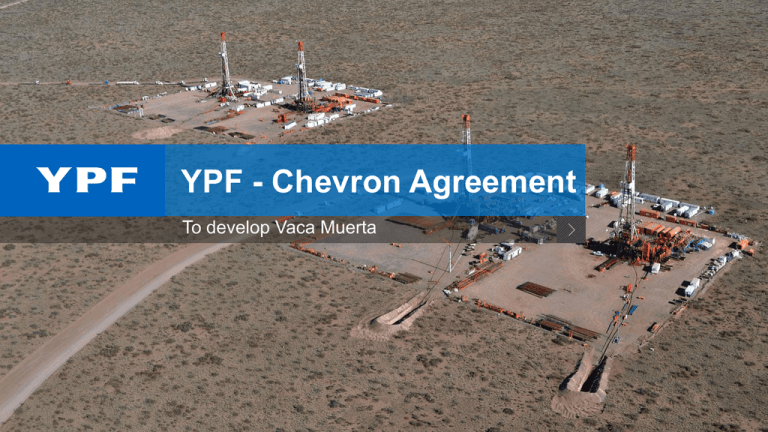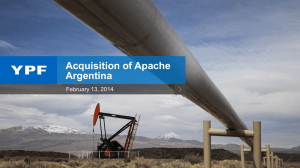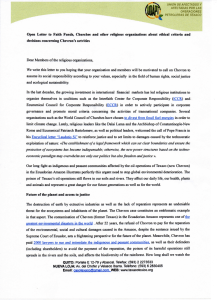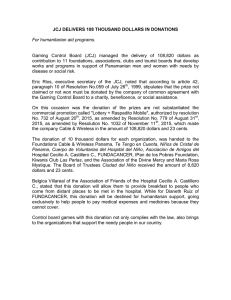Diapositiva 1
Anuncio

YPF - Chevron Agreement To develop Vaca Muerta Disclaimer Safe harbor statement under the US Private Securities Litigation Reform Act of 1995. This document contains statements that YPF believes constitute forward-looking statements within the meaning of the US Private Securities Litigation Reform Act of 1995. These forward-looking statements may include statements regarding the intent, belief, plans, current expectations or objectives of YPF and its management, including statements with respect to YPF’s future financial condition, financial, operating, reserve replacement and other ratios, results of operations, business strategy, geographic concentration, business concentration, production and marketed volumes and reserves, as well as YPF’s plans, expectations or objectives with respect to future capital expenditures, investments, expansion and other projects, exploration activities, ownership interests, divestments, cost savings and dividend payout policies. These forward-looking statements may also include assumptions regarding future economic and other conditions, such as future crude oil and other prices, refining and marketing margins and exchange rates. These statements are not guarantees of future performance, prices, margins, exchange rates or other events and are subject to material risks, uncertainties, changes and other factors which may be beyond YPF’s control or may be difficult to predict. YPF’s actual future financial condition, financial, operating, reserve replacement and other ratios, results of operations, business strategy, geographic concentration, business concentration, production and marketed volumes, reserves, capital expenditures, investments, expansion and other projects, exploration activities, ownership interests, divestments, cost savings and dividend payout policies, as well as actual future economic and other conditions, such as future crude oil and other prices, refining margins and exchange rates, could differ materially from those expressed or implied in any such forward-looking statements. Important factors that could cause such differences include, but are not limited to, oil, gas and other price fluctuations, supply and demand levels, currency fluctuations, exploration, drilling and production results, changes in reserves estimates, success in partnering with third parties, loss of market share, industry competition, environmental risks, physical risks, the risks of doing business in developing countries, legislative, tax, legal and regulatory developments, economic and financial market conditions in various countries and regions, political risks, wars and acts of terrorism, natural disasters, project delays or advancements and lack of approvals, as well as those factors described in the filings made by YPF and its affiliates with the Securities and Exchange Commission, in particular, those described in “Item 3. Key Information—Risk Factors” and “Item 5. Operating and Financial Review and Prospects” in YPF’s Annual Report on Form 20-F for the fiscal year ended December 31, 2012 filed with the US Securities and Exchange Commission. In light of the foregoing, the forward-looking statements included in this document may not occur. Except as required by law, YPF does not undertake to publicly update or revise these forward-looking statements even if experience or future changes make it clear that the projected performance, conditions or events expressed or implied therein will not be realized. These materials do not constitute an offer for sale of YPF S.A. bonds, shares or ADRs in the United States or otherwise. Agenda 1 The importance of Unconventional 2 Strategic partner and investment project magnitudes 3 Description of the agreements Energy Deficit Growing imports that do not favor the trade balance In 2011 Argentina became a net energy importer Exports and imports 6.5 6.5 6.5 Oil, fuels and natural gas Billion dollars Exports 3.8 2.0 Imports Shale offers Argentina the historical opportunity of stop being an energy importer 6.5 -2.9 Exports - Imports -2.8 -2.6 -4.5 Source: INDEC 2009 2010 -9.4 -9.3 2011 2012 Argentina’s hydrocarbons resource potential NOROESTE Oil potential Natural gas potential (Bbbls) (Tcf) 29 4.4 CUYANA NEUQUINA AUSTRAL Notes: Source SEN / U.S. Energy Information Administration (DOE) / Advanced Resources International (ARI), 2012 802 27 GOLFO SAN JORGE Conventional Conventional (Oil 3P + Resources) (Nat. gas 3P + Resources) Unconventional Unconventional (resources) (resources) 4th in UC oil resources 2nd in UC natural gas resources Vaca Muerta – World class asset Shale Oil and Gas Total Area 30,000 km2 EUR 20 - 40 Bbbl EUR 100 - 200 TCF Approximately 100 years of current production Net YPF New area 12,075 km2 Area Main unconventional acreage holders in America Chesapeake ExxonMobil YPF Chevron Apache (LLLN+LC) TOC (%) Thickness (mts) Pressure (psi) Area (km2) Vaca Muerta Barnett Haynesville Marcellus Eagle Ford Bakken 3-10 4-5 0.5-4 2-12 3-5 12 30-450 60-90 60-90 10-60 30-100 20-30 4,500-9,500 3,000-4,000 7,000-12,000 2,000-5,500 2,500-8,500 4,200 30,000 13,000 23,000 250,000 5,000 5,200 Source: SPE, Wood Mackenzie and YPF Vaca Muerta, LLLN – LC / Today Production (Unconventional) Number of Drilling Rigs 19 20 11,800 boe/d as of July 2013 +90 wells in production 18 15 16 14 11 12 10 7 8 6 4 4 3.3% of total YPF’s VM acreage (*) (*) 395 Km2 / 12,075 Km2 2 0 2011 Jun-2012 Jan-2013 Jun-2013 Dec-2013 Agenda 1 The importance of Unconventional 2 Strategic partner and investment project magnitudes 3 Description of the agreements Chevron – Experience and financial capacity 3rd oil company 5th producer In the world Of unconventional gas worldwide Market cap 235 billion dollars Sales (2012) 222 billion dollars 3rd holder Shale acreage, mainly in Marcellus and Utica (USA) Production 2,650 Kboe/d from which approximately 190 Kboe/d are from unconventional reservoirs. Chevron’s initial investment First 20 km2 - pilot 1 cluster Investment 1,240 20 km2 Massive development 290 Km2 million dollars Wells +100 Drilling rigs 19 (as of December 2013) Direct employees +1,500 Neuquina basin Vaca Muerta 700 drilling 300 transport 350 well services 160 stimulation Project Magnitudes - 35 years Total investment Total operating costs Drilling activity +16,000 +9,000 +1,500 Cumulative production Royalties to the Province Production Plateau Million dollars +750 Million BOEs Million dollars +8,500 Million dollars New wells +50,000 Barrels of oil per day +3 million m3 of natural gas per day Agenda 1 The importance of Unconventional 2 Strategic partner and investment project magnitudes 3 Description of the agreements Agreements between the different Parties Investment Agreement between YPF and Chevron (Signed 07/16/2013) Agreement between YPF and Neuquén (Signed 07/24/2013) (Ratified by Congress 08/28/2013) Creates the general framework for the investment with Chevron Unifies and extends for 35 years the Loma Campana concession of an area of 395 km2 • YPF will operate the development asset • Grant of 20 million dollars • Partnership: YPF 50%, Chevron 50% • Corporate Social Responsibility: 45 million dollars. • Investment amount: 1,240 million dollars in stages • Royalties: 12% • Pilot project: drilling +100 wells • Reduction to applicable Methanol Plant subsidy • 35 year term • Minimum investment: 1,000 million dollars • Net Profit Interest: 5% (starting year 2027) Investment Agreement YPF - Chevron / Schedule Pilot project for the drilling of + 100 wells in 20 km2 1st stage 1st disbursement: Chevron advances 300 million dollars to pay 50% of the investments made by YPF to date. YPF guarantees this amount until the execution of final legal documentation. 2nd disbursement: Once final legal documentation is signed, Chevron provides 940 million dollars as investments are required over the next 12 months. 2nd stage Once the pilot project is finished, Chevron may decide to continue in the massive development stage, in which +1,500 wells are estimated to be drilled and investments are estimated to be 15,000 million dollars. In case Chevron decides not to continue, they are only entitled to 50% of production from the wells drilled in the 1st Stage. Myths and realities about shale Myths Realities Hydraulic stimulation threatens ground water No. In Argentina hydrocarbons are separated by 2 km of rock from aquifers and groundwater is well protected with steel casing and cement Hydraulic stimulation compromises water supply No. In Neuquén only 0.1% of the river flow will only be used versus 5% used for irrigation and human consumption. The remaining 95% flows into the sea Hundreds of hazardous chemicals are used No. In Argentina only 3 to12 additives in very low concentrations are used. These chemicals can be found in ice cream, cheese, drinks and toiletries Shale is banned in most countries No. It was only banned in France and Bulgaria which have no precedent in the drilling of such wells Myths and realities of the YPF - Chevron Agreement 1/2 Myths Realities Chevron invests pesos that it already has in Argentina Dollars come from abroad through the sole free foreign exchange market for the total investment YPF guarantees product pricing to Chevron Prices will be the prevailing market prices at each moment without any guarantee from YPF YPF is giving away Vaca Muerta No. The agreement only contemplates the cession of 50% of 3.3% of the area that YPF has over Vaca Muerta and YPF will operate Chevron does not undertake any risk Chevron’s investment is totally at its own risk, it is only repaid with 50% of the project’s profits Chevron will have extraordinary profits Investment would be recovered only in the ninth year The Agreement is signed under French Law The agreements are subject to New York and Argentine Law, with arbitration in the ICC in Paris YPF deposits in an escrow account No. YPF will not deposit any dollars as guarantee The Agreement is a surrender of sovereignty Sovereignty is to not depend on foreign energy resources Myths and realities of the YPF - Chevron Agreement Myths 2/2 Realities The Agreement has secret clauses There are no secret clauses, it is just confidential in compliance with the regulations that apply to any publicly traded company YPF is a state-owned company Law 26,741, declared of public utility and subject to expropriation 51% of the equity interests in YPF S.A. In Section 15, the Law establishes that for the execution of the Company’s activities, YPF “shall continue to operate as a public company pursuant to Chapter II, Section V of Law Nº 19,550 and its corresponding regulations, and shall not be subject to any legislation or regulation applicable to the management or control of Companies or entities owned by the National Government or provincial governments”. YPF is not a state-owned company, but, as stated in the Law, is a corporation. For that reason, negotiations with Chevron were carried out in compliance with all obligations arising from both the Corporations Law as well as those arising from regulators and shareholders, as a company listed on the Buenos Aires and New York Stock Exchange. NUESTRA ENERGÍA



